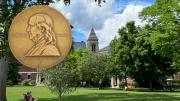In a public discourse defined increasingly by “post-factual” and policy-annihilating debate, Lesson Plan, by William G. Bowen and Michael S. McPherson, is a short, yet disarmingly rich and precise, primer on higher-education policy and its compelling relevance for the future of our economy and democracy. Two of the most respected figures in higher-education policy, the authors have led parallel and intertwined careers as economists, college and university presidents, foundation leaders, and scholars of higher education (Bowen as president emeritus of Princeton and of the Andrew W. Mellon Foundation, McPherson as president emeritus of Macalester College, and president of the Spencer Foundation). They are the authors of many of the most important empirical studies in higher education published during the past five decades, and those they did not write, they often sponsored, reviewed, participated in, or advised on. As a result, this latest collaboration—a slim, 140-page volume—combines the precision born of encyclopedic knowledge with the plain-spoken prose of experts for whom policy analysis is second nature.
With a didacticism appropriate to a lesson plan, Bowen and McPherson begin by reminding us of why we should care about getting higher-education policy right. Higher education itself is a “means of investing in human capital,” even “human improvement.” It equips people to “lead more productive and rewarding lives.” And, they point out (citing Harvard economists Claudia Goldin and Lawrence Katz), in a knowledge-driven economy characterized by the relentless advance of technology, it is our only hope for meeting the pressing national need for an increasingly educated and productive workforce.
These statements may seem self-evident—but Bowen and McPherson argue that they no longer actually guide our country’s approach to higher education. While our political discourse clings to the “conventional civic mythology” (quoting MIT economist David Autor, M.P.P. ’94, Ph.D. ’99) that higher education is the engine of economic opportunity and social mobility—the key to the American dream—the underlying reality has shifted fundamentally since the 1980s. In fact, the authors report, the United States now has both the lowest mobility and the highest inequality among all wealthy democratic countries. We will not fix this problem if higher education continues on its current path. As things stand, higher education increasingly mirrors and reinforces, rather than counterbalances, the inequality in opportunity and income that characterize our society at large.
According to the authors, any course correction requires moving beyond our current preoccupation with “access and affordability”—maximizing the number of people who begin college—and thinking instead about what we need to do to increase the number of people who complete a degree. In the United States, almost two-thirds of high-school graduates pursue some kind of post-secondary education, but the fraction of any given population group actually attaining a degree or credential is much smaller. Among 25- to 29-year-olds, for example, a mere 34 percent had bachelor’s degrees in 2014. These numbers have improved slightly in recent years, but the authors emphasize that current educational attainment rates are “simply too low to ensure the success of this country in a rapidly evolving global economy, and too low to give many Americans the improved life chances they deserve.”
Lesson Plan is particularly compelling on the question of unequal life chances and the role of higher education in perpetuating stark disparities in outcomes based on socioeconomic status. Bowen and McPherson offer extensive commentary on the fact that socioeconomic status trumps academic ability in determining who ends up with a college degree. A look at high-school sophomores from 2002 a decade later, for instance, reveals that 60 percent of high socioeconomic status (SES) students had a bachelor’s degree or higher, compared with just 14 percent of students from the lowest third of the socioeconomic spectrum. Adjusting for academic achievement, these differences persist. Almost three-quarters of high-SES students (74 percent) who scored in the highest category in math proficiency had achieved bachelor’s degrees 10 years later, compared with 41 percent of low-SES students with the same scores.
To address this problem, the authors argue that Americans need to think carefully about how to target scarce resources to meet critical goals—broadening educational attainment, not just access; investing in the two- and four-year public institutions that educate most students from disadvantaged backgrounds; reducing time to degree to increase completion rates; and strengthening academic support for students in critical subject areas.
The Community-College and Student-Debt Myths
It may take time, though, for these lessons to penetrate the political debate. Bowen and McPherson, for instance, are sharply critical of President Obama’s proposal to make community college free for a large portion of the student population. They argue that steering students—particularly the most vulnerable ones—to community college is not the way to achieve the pressing need to increase the number of people who complete bachelor’s degrees, and have both the credentials and the knowledge to show for it. According to the authors, students who begin at four-year colleges have a much higher probability (as much as 30 percentage points or more) of receiving an A.B. than do students who aspire to that degree but start out at two-year institutions. Thus, a policy that establishes a price differential between the first two years at a community college versus a four-year college risks setting the least advantaged students up for failure.
And if the argument implicit in the Obama community-college proposal is that getting students through a two-year skills-oriented program is sufficient, that effort is equally misguided, Bowen and McPherson assert. Given the impact of technology and globalization on labor, it is routine skills and procedures that are most amenable to computerization—a reality that reduces the half-life of highly targeted, vocationally focused education. By contrast, the skills learned in earning a bachelor’s degree—tasks that demand critical thinking, judgment, flexibility, and the exercise of common sense—are hardest to replace with machines, and thus most durable over a lifetime of employment.
Bowen and McPherson are equally skeptical of the calls heard from various presidential candidates to make college “free” for everyone, or the related suggestion that college should be “debt-free” for students. With characteristic matter-of-factness, they point out that someone actually needs to pay the direct institutional costs of education. Thus focusing exclusively on the price for the individual student is simply an exercise in cost-shifting: reducing the price charged one group of citizens and shifting it to an unspecified other.
Similarly, say the authors, the issue of student debt, as dramatized in the current election cycle, is seriously overblown. Not surprisingly, as economists, they see nothing wrong with expecting students with good earnings prospects to pay back part of the costs incurred by taxpayers and others in educating them. Of course, the point here is “good earnings prospects,” which materialize only for students who actually complete their degrees. In fact, as Bowen and McPherson point out, the average student debt of a bachelor’s-degree recipient who borrows (and 30 percent don’t borrow at all) is around $30,000: roughly the amount of a new-car loan. Debt is most troubling for those students who fail to complete their degrees and end up behind where they started, even with small amounts of debt, or for students who enroll in high-debt, low pay-off programs such as those offered by many of the for-profit institutions. Bowen and McPherson point out that the for-profit sector accounts for about 8 percent of total higher-education enrollment, while generating 44 percent of federal student-loan defaults.
Solutions Wanting
As this discussion suggests, Bowen and McPherson are most effective when they are parsing the issues at the heart of higher-education policy, exposing myths, and calibrating—as no one can do better—how we should define our policy goals and where we should target solutions. But when they set out to define an “Agenda for Change,” their arguments begin to lose focus and conviction.
The most striking example arises in their discussion of transforming the federal role in higher education from “passive check-writing” (funding individuals through Pell grants, campus-based aid, and student loans) to “more active attempts” to promote college completion and greater accountability by funding states or institutions directly, creating a stronger federal role in providing information and counseling, running experiments to test innovations, and working with states and institutions to measure their performance and outcomes. Although the authors note that previous efforts at an activist federal role have been highly problematic—as in the Education Department’s recent, misguided, and ultimately abandoned, attempt to create a ratings system for colleges—they don’t seem to draw the most obvious conclusion: that increasing the heavy-handedness of the federal government in higher education may not be the best solution to the problems they so compellingly identify. It is a standard trope that the success of American higher education is due in no small part to an enabling, but circumspect, federal role. The fact that this structure has failed to ensure the equality of opportunity and substantive outcomes we would all wish for does not necessarily mean that a solution is to be found in a more active and intrusive federal government.
When the authors turn to other questions, such as how to take costs out of the higher-education system writ large, the “Agenda for Change” runs even further afield. They rightly suggest, for instance, that we have too many doctoral programs at second- and third-tier institutions generating an over-supply of Ph.D.’s in the marketplace. Yet the solution they proffer is simply a call for a “tough reexamination of real national needs and costs,” without much hope for success.Similarly, they discuss the “reckless and wasteful” and integrity-destroying role of high-profile sports at many institutions. Yet, again, the authors are short on solutions. They cite legal challenges to the system or direct governmental action as the only realistic (but not at all likely) path forward. Finally, although they correctly note the promise of “adaptive learning”—a blend of face-to-face instruction with technology-assisted feedback loops—for improving student outcomes, they fail to explain how the institutions serving the most needy students can acquire the capital and expertise required to make progress in this domain.
These caveats notwithstanding, Lesson Plan is an invaluable guide for anyone who cares about the core American value of equal opportunity, and the role higher education has and should continue to play in translating this value into economic vitality and a healthy democracy. One hopes that the wisdom offered by these distinguished scholars will find a receptive audience as this consequential political season continues to unfold.









